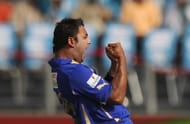Damien Fleming to Lance Klusener; one wicket left; 1 to get off 3 balls; all fielders close in to save the single; Klusener drills it down the ground, and, amidst confusion, they set off for a run. Mark Waugh, at mid-on, cleans up and flicks it to Fleming, who sets it up for Adam Gilchrist at the other end to break the stumps. Its over! Australia will play Pakistan for the 1999 World Cup.
A missed run out chance in the previous delivery did not deter the Man-of-the-Series Lance Klusener, who had since then personified nerves of steel, from attempting a suicidal run that brought the curtains down on South Africa’s hopes. After directing almost every match in South Africa’s way, his 31 off 14 against Australia was unfortunately the last of his astonishing performances in the ’99 World Cup. His 52 off 45 balls took the attack to Sri Lanka at Northampton, 48 off 40 sent England packing at The Oval, and 46 off 41 proved to be enough against Pakistan at Trent Bridge. Add 17 wickets to that, it was one of the most memorable individual shows ever in a world cup.
As for the Australian team that went on to lift the World Cup that year, Tom Moody’s quick-fire cameos coupled with his economical bowling did the trick. His outputs justified his inclusion in the squad: a last-minute decision by the team management looking at the nature of pitches in England.
These are just a few instances that exemplify the massive impact of fast bowling/medium pace all-rounders in the world cups played outside the subcontinent. It is a phenomena triggered by India’s 1983 triumph, which ended the Caribbean domination in limited overs cricket.
The champion Indian squad that year comprised of numerous players who could perform with both bat and ball. Kapil Dev, India’s greatest all-rounder of all time, led from the front with his heroic 175 against Zimbabwe, along with contributions from Mohinder Amarnath, Roger Binny, Madan Lal and others: the importance of players with dual abilities was gloriously highlighted.
Almost a decade later, another captain (also an all-rounder) from the sub-continent led his team to glory in the Benson and Hedges World Cup hosted Down Under. Imran Khan’s 1992 heroics have long been engraved in the memories of all those who had witnessed him leading Pakistan to their biggest achievement in international cricket.
The last two conquests of the treble-winning Australians were also marked by significant yet understated parts played by players who excelled with both bat and ball. Andy Bichel’s 2003 heroics included a crucial lower-order partnership with Bevan combined with a 7-wicket rampage that sent England home. While 4 years later in the West Indian islands, Shane Watson’s key all-round contributions formed an integral part of the 2007 World Cup winning Aussie squad.
With hardly a year remaining for the 2015 World Cup, most of the top ODI teams are envisioning at least one such player in their lineup for the competition. James Faulkner’s emergence as a smashing batsman has boosted the Kangaroos, who have always been more open to play all-rounders. Corey Anderson’s belligerence with the bat and follow up acts with the ball have given another promising option to the Kiwis. Sri Lankan captain Angelo Mathews is a fine example of versatility, while Stuart Broad adds depth to the English batting. Being one of the best bowlers in the world, Vernon Philander has flaunted his abilities with the bat time and again.
In contrast to these teams, Team India’s preparations don’t seem to be unfolding on the same lines. The Men in Blue have failed to win any of their last eight overseas ODIs. In spite of possessing variety in the squad, the Indian team failed to experiment throughout their 4-0 drubbing in New Zealand. As a result, Stuart Binny, the only medium pace all-rounder in the team, ended the tour having bowled only one over and not faced a single delivery.
Binny, who played an important part in Karnataka’s Ranji Trophy triumph in the 2013-14 season, upon coming back from New Zealand, soon proved his mettle, this time in the Irani Trophy with an impressive all-round performance that saw him smack a 82-ball hundred.
Another such player who has quickly climbed up the ranks is Rishi Dhawan. The Himachal Pradesh all-rounder, who first broke into the scenes while playing for Mumbai Indians in the Indian Premier League, has had a memorable few months in the domestic circuit. Along with being the season’s highest wicket-taker by grabbing 49 wickets, he also recorded five fifties at an average of close to 40 with the bat.
Over the past decade or so, similar domestic performers have either been constantly overlooked or have not been given enough long runs in the national team. Abhishek Nayar, Lakshmi Ratan Shukla and Rajat Bhatia are prime examples of the same. The likes of Irfan Pathan have done themselves no good by being inconsistent and unfit.
All said and done, the continuously evolving dynamics of the 50-over game demand the inclusion one such utility player in the team. Ahead of the 2015 World Cup, India have to sort out a whole bunch of issues: one among them is a medium pacer who can bat.
Follow IPL Auction 2025 Live Updates, News & Biddings at Sportskeeda. Get the fastest updates on Mega-Auction and cricket news

